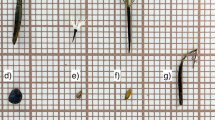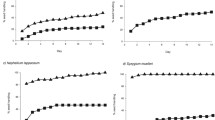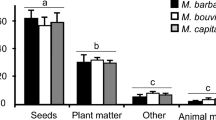Summary
Utilization of non-native seeds by seed-eating rodents and ants was studied experimentally in the field. It was found that patterns of granivory in the Israeli deserts are very similar to those reported for the same groups in the deserts of North America. Rodents are more efficient than ants at finding and harvesting seeds. Only rodents can find and harvest seeds that occur below the soil surface.
The two taxa appear to rank barley particles on the basis of size. Big seeds are utilized first and the shift to small seeds occurs only after most of the big seeds have been utilized. This result agrees with the prediction of optimal diet theory.
Similar content being viewed by others
References
Bernstein RA (1974) Seasonal food abundance and foraging activity in some desert ants. Amer Natur 108:490–498
Brown JH, Davidson DW (1977) Competition between seed-eating rodents and ants in desert ecosystems. Science 196:880–882
Brown JH, Grover JJ, Davidson DW, Lieberman GA (1975) A preliminary study of seed predation in desert and montane habitats. Ecology 46:987–992
Brown JH, Davidson DW, Reichman OJ (1979c) An experimental study of competition between seed-eating desert rodents and ants. Amer Zool 19:1129–1143
Brown JH, Reichman OJ, Davidson DW (1979b) Granivory in desert ecosystems. Ann Rev Ecol Syst 10:201–227
Davidson DW (1977) Foraging ecology and community organization in desert seed-eating ants. Ecology 58:725–737
Davidson DW (1978) Experimental tests of the optimal diet in two social insects. Behav Ecol Sociobiol 4:35–41
Inouye RS, Byers GS, Brown JH (1980) Effects of predation and competition on surviorship, fecundity, and community structure of desert annuals. Ecology 61:1344–1351
Lockard RB, Lockard JS (1971) Seed preference and buried seed retrieval of Dipodomys deserti. J Mammal 52:219–221
Mares MA, Rosenzweig ML (1978) Granivory in North and South American deserts: rodents, birds, and ants. Ecology 59:235–241
Orians GH, Pearson NE (1977) On the theory of central place foraging. In: Horn DF (ed) Analysis of ecological systems. Columbus: Ohio State Univ Press
Pyke CH, Pulliam HR, Charnov EL (1977) Optimal foraging: a selective review of theory and tests. Q Rev Biol 52:137–154
Reichman OJ (1981) Desert granivore foraging and its impact on seed densities and distributions. Ecology 60:1085–1092
Reichman OJ, Oberstein D (1977) Selection of seed distribution types by Dipodomys merriami and Perognathus amplus. Ecology 58:636–643
Smigel BW, Rosenzweig ML (1974) Experimental test for seed size selection and allocation in Dipodomys merriami and Perognatus penicillatus. Ecology 55:329–339
Whitford WG, Ettenshank G (1975) Factors affecting foraging activity in Chihuahua desert harvester ants. Environmental Entomol 5:689–696
Zahavi A, Wahrman J (1957) The cytotaxonomy ecology and evolution of the gerbillus and jinds of Israel (Rodentia: gerbillinae). Mammalia 21:341–380
Author information
Authors and Affiliations
Rights and permissions
About this article
Cite this article
Abramsky, Z. Experiments on seed predation by rodents and ants in the Israeli desert. Oecologia 57, 328–332 (1983). https://doi.org/10.1007/BF00377176
Received:
Issue Date:
DOI: https://doi.org/10.1007/BF00377176




